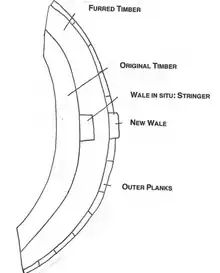Wale (ship part)
A wale is one of the strakes of wooden planking that forms the outer skin of the hull of a ship, but substantially thicker than the other strakes. It provides extra stiffening and strength to the hull. It was a common feature of heavy wooden ship construction, particularly from the Middle Ages to the early years of the 19th century, being a major constructional component of ships like USS Constitution, HMS Victory and many earlier vessels.[1][2]

A wale (or "waler") is a horizontal supporting member of a concrete forming system, vertically reinforced by a "strongback".
A wale is also a horizontal member of a geotechnical tieback wall, which transmits the force from the tieback to the beams.
See also
References
- Ball, Nick; Stephens, Simon (2018). "Glossary". Navy Board Ship Models. Barnsley: Seaforth Publishing. ISBN 978-1-5267-0111-4.
- Steffy, J. Richard (2013) [1994]. "Illustrated Glossary of Ship and Boat Terms". In Catsambis, Alexis (ed.). The Oxford Handbook of Maritime Archaeology (Oxford Handbooks). Oxford: Oxford University Press. ISBN 978-0-19-537517-6.
External links
![]() Media related to Wale (ship parts) at Wikimedia Commons
Media related to Wale (ship parts) at Wikimedia Commons
 The dictionary definition of wale at Wiktionary
The dictionary definition of wale at Wiktionary